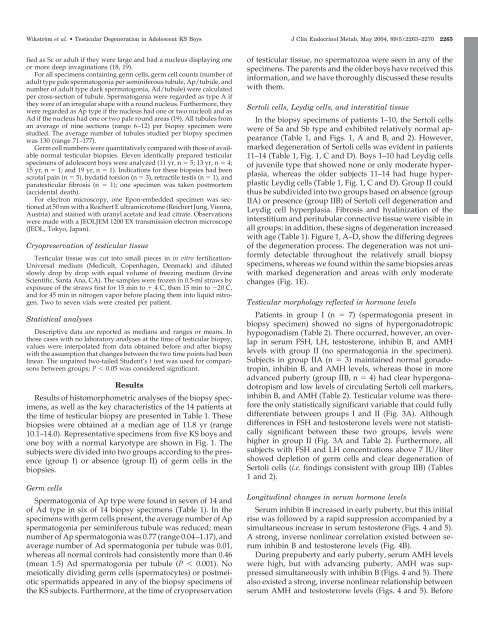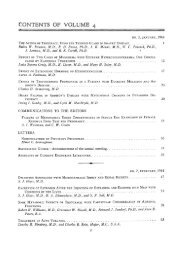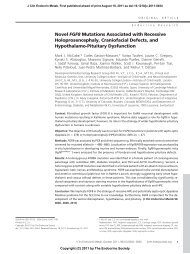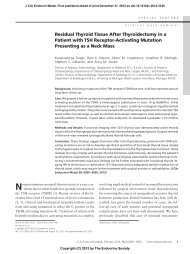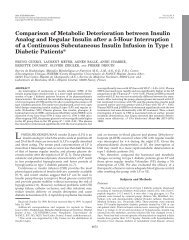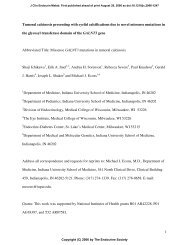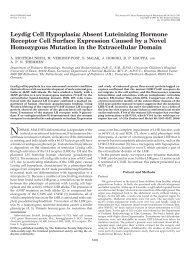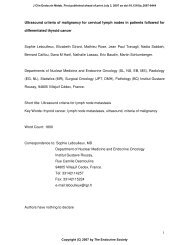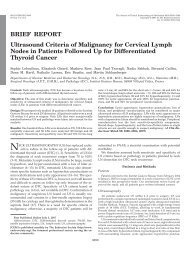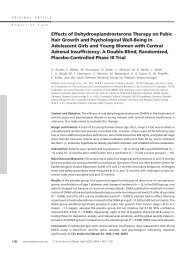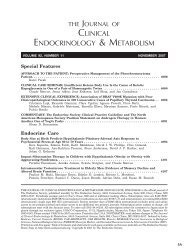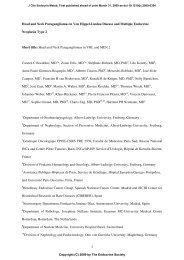Klinefelter Syndrome in Adolescence - The Journal of Clinical ...
Klinefelter Syndrome in Adolescence - The Journal of Clinical ...
Klinefelter Syndrome in Adolescence - The Journal of Clinical ...
Create successful ePaper yourself
Turn your PDF publications into a flip-book with our unique Google optimized e-Paper software.
Wikström et al. Testicular Degeneration <strong>in</strong> Adolescent KS Boys J Cl<strong>in</strong> Endocr<strong>in</strong>ol Metab, May 2004, 89(5):2263–2270 2265<br />
fied as Sc or adult if they were large and had a nucleus display<strong>in</strong>g one<br />
or more deep <strong>in</strong>vag<strong>in</strong>ations (18, 19).<br />
For all specimens conta<strong>in</strong><strong>in</strong>g germ cells, germ cell counts (number <strong>of</strong><br />
adult type pale spermatogonia per sem<strong>in</strong>iferous tubule, Ap/tubule, and<br />
number <strong>of</strong> adult type dark spermatogonia, Ad/tubule) were calculated<br />
per cross-section <strong>of</strong> tubule. Spermatogonia were regarded as type A if<br />
they were <strong>of</strong> an irregular shape with a round nucleus. Furthermore, they<br />
were regarded as Ap type if the nucleus had one or two nucleoli and as<br />
Ad if the nucleus had one or two pale round areas (19). All tubules from<br />
an average <strong>of</strong> n<strong>in</strong>e sections (range 6–12) per biopsy specimen were<br />
studied. <strong>The</strong> average number <strong>of</strong> tubules studied per biopsy specimen<br />
was 130 (range 71–177).<br />
Germ cell numbers were quantitatively compared with those <strong>of</strong> available<br />
normal testicular biopsies. Eleven identically prepared testicular<br />
specimens <strong>of</strong> adolescent boys were analyzed (11 yr, n 5; 13 yr, n 4;<br />
15 yr, n 1; and 19 yr, n 1). Indications for these biopsies had been<br />
scrotal pa<strong>in</strong> (n 5), hydatid torsion (n 3), retractile testis (n 1), and<br />
paratesticular fibrosis (n 1); one specimen was taken postmortem<br />
(accidental death).<br />
For electron microscopy, one Epon-embedded specimen was sectioned<br />
at 50 nm with a Reichert E ultramicrotome (Reichert Jung, Vienna,<br />
Austria) and sta<strong>in</strong>ed with uranyl acetate and lead citrate. Observations<br />
were made with a JEOLJEM 1200 EX transmission electron microscope<br />
(JEOL, Tokyo, Japan).<br />
Cryopreservation <strong>of</strong> testicular tissue<br />
Testicular tissue was cut <strong>in</strong>to small pieces <strong>in</strong> <strong>in</strong> vitro fertilization-<br />
Universal medium (Medicult, Copenhagen, Denmark) and diluted<br />
slowly drop by drop with equal volume <strong>of</strong> freez<strong>in</strong>g medium (Irv<strong>in</strong>e<br />
Scientific, Santa Ana, CA). <strong>The</strong> samples were frozen <strong>in</strong> 0.5-ml straws by<br />
exposure <strong>of</strong> the straws first for 15 m<strong>in</strong> to 4 C, then 15 m<strong>in</strong> to 20 C,<br />
and for 45 m<strong>in</strong> <strong>in</strong> nitrogen vapor before plac<strong>in</strong>g them <strong>in</strong>to liquid nitrogen.<br />
Two to seven vials were created per patient.<br />
Statistical analyses<br />
Descriptive data are reported as medians and ranges or means. In<br />
those cases with no laboratory analyses at the time <strong>of</strong> testicular biopsy,<br />
values were <strong>in</strong>terpolated from data obta<strong>in</strong>ed before and after biopsy<br />
with the assumption that changes between the two time po<strong>in</strong>ts had been<br />
l<strong>in</strong>ear. <strong>The</strong> unpaired two-tailed Student’s t test was used for comparisons<br />
between groups; P 0.05 was considered significant.<br />
Results<br />
Results <strong>of</strong> histomorphometric analyses <strong>of</strong> the biopsy specimens,<br />
as well as the key characteristics <strong>of</strong> the 14 patients at<br />
the time <strong>of</strong> testicular biopsy are presented <strong>in</strong> Table 1. <strong>The</strong>se<br />
biopsies were obta<strong>in</strong>ed at a median age <strong>of</strong> 11.8 yr (range<br />
10.1–14.0). Representative specimens from five KS boys and<br />
one boy with a normal karyotype are shown <strong>in</strong> Fig. 1. <strong>The</strong><br />
subjects were divided <strong>in</strong>to two groups accord<strong>in</strong>g to the presence<br />
(group I) or absence (group II) <strong>of</strong> germ cells <strong>in</strong> the<br />
biopsies.<br />
Germ cells<br />
Spermatogonia <strong>of</strong> Ap type were found <strong>in</strong> seven <strong>of</strong> 14 and<br />
<strong>of</strong> Ad type <strong>in</strong> six <strong>of</strong> 14 biopsy specimens (Table 1). In the<br />
specimens with germ cells present, the average number <strong>of</strong> Ap<br />
spermatogonia per sem<strong>in</strong>iferous tubule was reduced; mean<br />
number <strong>of</strong> Ap spermatogonia was 0.77 (range 0.04–1.17), and<br />
average number <strong>of</strong> Ad spermatogonia per tubule was 0.01,<br />
whereas all normal controls had consistently more than 0.46<br />
(mean 1.5) Ad spermatogonia per tubule (P 0.001). No<br />
meiotically divid<strong>in</strong>g germ cells (spermatocytes) or postmeiotic<br />
spermatids appeared <strong>in</strong> any <strong>of</strong> the biopsy specimens <strong>of</strong><br />
the KS subjects. Furthermore, at the time <strong>of</strong> cryopreservation<br />
<strong>of</strong> testicular tissue, no spermatozoa were seen <strong>in</strong> any <strong>of</strong> the<br />
specimens. <strong>The</strong> parents and the older boys have received this<br />
<strong>in</strong>formation, and we have thoroughly discussed these results<br />
with them.<br />
Sertoli cells, Leydig cells, and <strong>in</strong>terstitial tissue<br />
In the biopsy specimens <strong>of</strong> patients 1–10, the Sertoli cells<br />
were <strong>of</strong> Sa and Sb type and exhibited relatively normal appearance<br />
(Table 1, and Figs. 1, A and B, and 2). However,<br />
marked degeneration <strong>of</strong> Sertoli cells was evident <strong>in</strong> patients<br />
11–14 (Table 1, Fig. 1, C and D). Boys 1–10 had Leydig cells<br />
<strong>of</strong> juvenile type that showed none or only moderate hyperplasia,<br />
whereas the older subjects 11–14 had huge hyperplastic<br />
Leydig cells (Table 1, Fig. 1, C and D). Group II could<br />
thus be subdivided <strong>in</strong>to two groups based on absence (group<br />
IIA) or presence (group IIB) <strong>of</strong> Sertoli cell degeneration and<br />
Leydig cell hyperplasia. Fibrosis and hyal<strong>in</strong>ization <strong>of</strong> the<br />
<strong>in</strong>terstitium and peritubular connective tissue were visible <strong>in</strong><br />
all groups; <strong>in</strong> addition, these signs <strong>of</strong> degeneration <strong>in</strong>creased<br />
with age (Table 1). Figure 1, A–D, show the differ<strong>in</strong>g degrees<br />
<strong>of</strong> the degeneration process. <strong>The</strong> degeneration was not uniformly<br />
detectable throughout the relatively small biopsy<br />
specimens, whereas we found with<strong>in</strong> the same biopsies areas<br />
with marked degeneration and areas with only moderate<br />
changes (Fig. 1E).<br />
Testicular morphology reflected <strong>in</strong> hormone levels<br />
Patients <strong>in</strong> group I (n 7) (spermatogonia present <strong>in</strong><br />
biopsy specimen) showed no signs <strong>of</strong> hypergonadotropic<br />
hypogonadism (Table 2). <strong>The</strong>re occurred, however, an overlap<br />
<strong>in</strong> serum FSH, LH, testosterone, <strong>in</strong>hib<strong>in</strong> B, and AMH<br />
levels with group II (no spermatogonia <strong>in</strong> the specimen).<br />
Subjects <strong>in</strong> group IIA (n 3) ma<strong>in</strong>ta<strong>in</strong>ed normal gonadotrop<strong>in</strong>,<br />
<strong>in</strong>hib<strong>in</strong> B, and AMH levels, whereas those <strong>in</strong> more<br />
advanced puberty (group IIB, n 4) had clear hypergonadotropism<br />
and low levels <strong>of</strong> circulat<strong>in</strong>g Sertoli cell markers,<br />
<strong>in</strong>hib<strong>in</strong> B, and AMH (Table 2). Testicular volume was therefore<br />
the only statistically significant variable that could fully<br />
differentiate between groups I and II (Fig. 3A). Although<br />
differences <strong>in</strong> FSH and testosterone levels were not statistically<br />
significant between these two groups, levels were<br />
higher <strong>in</strong> group II (Fig. 3A and Table 2). Furthermore, all<br />
subjects with FSH and LH concentrations above 7 IU/liter<br />
showed depletion <strong>of</strong> germ cells and clear degeneration <strong>of</strong><br />
Sertoli cells (i.e. f<strong>in</strong>d<strong>in</strong>gs consistent with group IIB) (Tables<br />
1 and 2).<br />
Longitud<strong>in</strong>al changes <strong>in</strong> serum hormone levels<br />
Serum <strong>in</strong>hib<strong>in</strong> B <strong>in</strong>creased <strong>in</strong> early puberty, but this <strong>in</strong>itial<br />
rise was followed by a rapid suppression accompanied by a<br />
simultaneous <strong>in</strong>crease <strong>in</strong> serum testosterone (Figs. 4 and 5).<br />
A strong, <strong>in</strong>verse nonl<strong>in</strong>ear correlation existed between serum<br />
<strong>in</strong>hib<strong>in</strong> B and testosterone levels (Fig. 4B).<br />
Dur<strong>in</strong>g prepuberty and early puberty, serum AMH levels<br />
were high, but with advanc<strong>in</strong>g puberty, AMH was suppressed<br />
simultaneously with <strong>in</strong>hib<strong>in</strong> B (Figs. 4 and 5). <strong>The</strong>re<br />
also existed a strong, <strong>in</strong>verse nonl<strong>in</strong>ear relationship between<br />
serum AMH and testosterone levels (Figs. 4 and 5). Before


